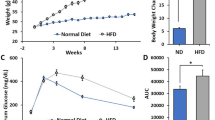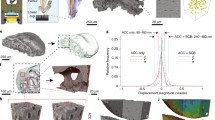Abstract
The pathological changes in osteoarthritis—a degenerative joint disease prevalent among older people—start at the molecular scale and spread to the higher levels of the architecture of articular cartilage to cause progressive and irreversible structural and functional damage. At present, there are no treatments to cure or attenuate the degradation of cartilage. Early detection and the ability to monitor the progression of osteoarthritis are therefore important for developing effective therapies. Here, we show that indentation-type atomic force microscopy can monitor age-related morphological and biomechanical changes in the hips of normal and osteoarthritic mice. Early damage in the cartilage of osteoarthritic patients undergoing hip or knee replacements could similarly be detected using this method. Changes due to aging and osteoarthritis are clearly depicted at the nanometre scale well before morphological changes can be observed using current diagnostic methods. Indentation-type atomic force microscopy may potentially be developed into a minimally invasive arthroscopic tool to diagnose the early onset of osteoarthritis in situ.
This is a preview of subscription content, access via your institution
Access options
Subscribe to this journal
Receive 12 print issues and online access
$259.00 per year
only $21.58 per issue
Buy this article
- Purchase on Springer Link
- Instant access to full article PDF
Prices may be subject to local taxes which are calculated during checkout




Similar content being viewed by others
Change history
04 November 2010
In the version of this Article originally published, a systematic error affected all the values of microstiffness presented in the paper (including in the figures and figure captions). This error resulted in all the values of microstiffness being too high by a factor of √π. The values for nanostiffness are not affected and this error does not affect the conclusions of the paper. This error has now been corrected in the HTML and PDF versions of the text. The Supplementary Information and corresponding e-mail address have also been updated.
References
Mankin, H. J., Mow, V., Buckwalter, J., Iannotti, J. & Ratcliffe, A. in Orthopaedic Basic Science (ed. Simon, S. R.) Ch. 1, 443–488 (American Academy of Orthopaedic Surgeons, 1994).
Buckwalter, J. A., Mankin, H. J. & Grodzinsky, A. J. Articular cartilage and osteoarthritis. Instr. Course Lect. 54, 465–480 (2005).
Burstein, D. & Gray, M. L. Is MRI fulfilling its promise for molecular imaging of cartilage in arthritis? Osteoarthritis Cartilage 14, 1087–1090 (2006).
Qazi, A. A. et al. Separation of healthy and early osteoarthritis by automatic quantification of cartilage homogeneity. Osteoarthritis Cartilage 15, 1199–1206 (2007).
Li, X. et al. In vivo T(1rho) and T(2) mapping of articular cartilage in osteoarthritis of the knee using 3 T MRI. Osteoarthritis Cartilage 15, 789–797 (2007).
Mansfield, P. & Glover, P. M. Limits to magnetic resonance microscopy. Rep. Prog. Phys. 65, 1489–1511 (2002).
Xia, Y. Resolution ‘scaling law’ in MRI of articular cartilage. Osteoarthritis Cartilage 15, 363–365 (2007).
Poole, A. R. Biochemical/immunochemical biomarkers of osteoarthritis: utility for prediction of incident or progressive osteoarthritis. Rheum. Dis. Clin. North Am. 29, 803–818 (2003).
Lamers, R. J. et al. Identification of an urinary metabolite profile associated with osteoarthritis. Osteoarthritis Cartilage 13, 762–768 (2005).
Kleemann, R. U., Krocker, D., Cedraro, A., Tuischer, J. & Duda, G. N. Altered cartilage mechanics and histology in knee osteoarthritis: relation to clinical assessment (ICRS Grade). Osteoarthritis Cartilage 13, 958–963 (2005).
Stolz, M. et al. Dynamic elastic modulus of porcine articular cartilage determined at two different levels of tissue organization by indentation-type atomic force microscopy. Biophys. J. 86, 3269–3283 (2004).
Hu, K. et al. Pathogenesis of osteoarthritis-like changes in the joints of mice deficient in type IX collagen. Arthritis Rheum. 54, 2891–2900 (2006).
Fassler, R. et al. Mice lacking alpha 1 (IX) collagen develop noninflammatory degenerative joint disease. Proc. Natl Acad. Sci. USA 91, 5070–5074 (1994).
Bruckner, P. & van der Rest, M. Structure and function of cartilage collagens. Microsc. Res. Tech. 28, 378–384 (1994).
Asamura, K. et al. Type IX collagen is crucial for normal hearing. Neuroscience 132, 493–500 (2005).
Outerbridge, R. E. & Dunlop, J. A. The problem of chondromalacia patellae. Clin. Orthop. Relat. Res. 177–196 (1975).
Outerbridge, R. E. The etiology of chondromalacia patellae. J. Bone Joint Surg. Br. 43-B, 752–757 (1961).
Buckwalter, J. A., Kuettner, K. E. & Thonar, E. J. Age-related changes in articular cartilage proteoglycans: electron microscopic studies. J. Orthop. Res. 3, 251–257 (1985).
Poole, A. R. An introduction to the pathophysiology of osteoarthritis. Front. Biosci. 4, D662–670 (1999).
Hollander, A. P. et al. Damage to type II collagen in aging and osteoarthritis starts at the articular surface, originates around chondrocytes, and extends into the cartilage with progressive degeneration. J. Clin. Invest. 96, 2859–2869 (1995).
Bayliss, M. T., Osborne, D., Woodhouse, S. & Davidson, C. Sulfation of chondroitin sulfate in human articular cartilage. The effect of age, topographical position and zone of cartilage on tissue composition. J. Biol. Chem. 274, 15892–15900 (1999).
Carney, S. L. & Muir, H. The structure and function of cartilage proteoglycans. Physiol. Rev. 68, 858–910 (1988).
Yang, L. et al. Micromechanical bending of single collagen fibrils using atomic force microscopy. J. Biomed. Mater. Res. A 82, 160–168 (2007).
Stolz, M., Imer, R., Staufer, U. & Aebi, U. Development of an arthroscopic atomic force microscope. BioWorld 4, 2–5 (2003).
Imer, R. et al. Development of atomic force microscope for arthroscopic knee cartilage inspection. Jpn J. Appl. Phys. 45, 2319–2323 (2006).
Segawa, K. & Takiguchi, R. Ultrastructural alteration of cartilaginous fibril arrangement in the rat mandibular condyle as revealed by high-resolution scanning electron microscopy. Anat. Rec. 234, 493–499 (1992).
Farndale, R. W., Buttle, D. J. & Barrett, A. J. Improved quantitation and discrimination of sulphated glycosaminoglycans by use of dimethylmethylene blue. Biochim. Biophys. Acta 883, 173–177 (1986).
Acknowledgements
This work was supported by an NCCR program grant on ‘Nanoscale Science’ awarded by the Swiss National Science Foundation, the M. E. Müller Foundation of Switzerland, the Canton Basel-Stadt, and the Max Planck Society. Part of the work has also been supported by the Hardy and Otto Frey-Zünd Foundation, ProMotio Foundation for Biomechanical Research and other private promoters supporting the efforts of the University of Basel Laboratory for Orthopedic Biomechanics. Moreover, we thank Nanoworld AG (L. Aeschimann, M. Burri) for the silicon AFM probes and for the SEM image of the microspherical tip, and Z. Farkas for technical assistance. The authors thank F. Wolf for some of the glycosaminoglycan/DNA analysis. We thank T. Staehelin for critical review of the manuscript and discussion of the data, and Z. Housley for proofreading the manuscript.
Author information
Authors and Affiliations
Contributions
M.S., W.B., A.A. and U.A. conceived and designed the experiments. R.R. developed the software for analysing force maps. R.I. and U.S. developed and produced the microfabricated spherical tips. N.F. provided all issues related to clinics. M.S., R.G., S.M., A.R., M.D. and A.A. performed the experiments. M.S., I.M., A.D., A.A. and U.A. co-wrote the paper. All authors discussed the results and commented on the manuscript.
Corresponding author
Supplementary information
Supplementary Information
Supplementary Information (PDF 597 kb)
Rights and permissions
About this article
Cite this article
Stolz, M., Gottardi, R., Raiteri, R. et al. Early detection of aging cartilage and osteoarthritis in mice and patient samples using atomic force microscopy. Nature Nanotech 4, 186–192 (2009). https://doi.org/10.1038/nnano.2008.410
Received:
Accepted:
Published:
Issue Date:
DOI: https://doi.org/10.1038/nnano.2008.410
This article is cited by
-
Age-related matrix stiffening epigenetically regulates α-Klotho expression and compromises chondrocyte integrity
Nature Communications (2023)
-
The future of basic science in orthopaedics and traumatology: Cassandra or Prometheus?
European Journal of Medical Research (2021)
-
Biochemical and Morphological Abnormalities of Subchondral Bone and Their Association with Cartilage Degeneration in Spontaneous Osteoarthritis
Calcified Tissue International (2021)
-
Impact of resistance exercises and nano-curcumin on synovial levels of collagenase and nitric oxide in women with knee osteoarthritis
Translational Medicine Communications (2020)
-
Alterations in articular cartilage T2 star relaxation time following mechanical disorders: in vivo canine supraspinatus tendon resection models
BMC Musculoskeletal Disorders (2020)



